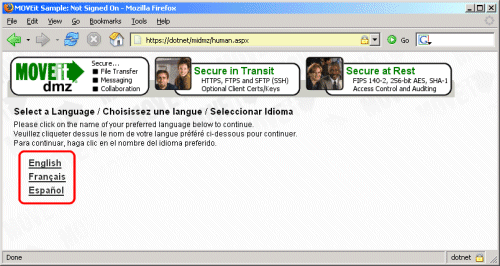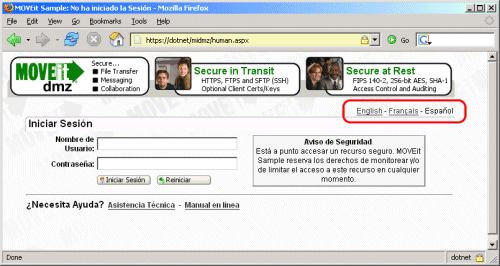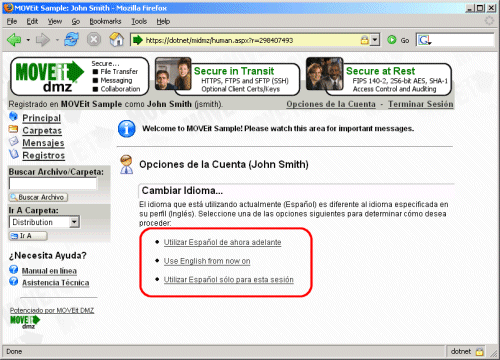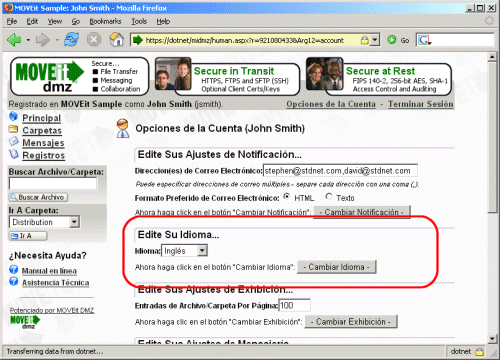
(a.k.a. "Localization" or "Internationalization" or "Translation")
The Web, FTP and SSH Interfaces of MOVEit DMZ will be displayed in non-English languages if the International Languages feature of MOVEit DMZ is enabled. Currently, French, Spanish, and German are the only non-English languages supported.
Each user is given several opportunities to select a language, even before signing on.
In the style of many Canadian bilingual sites, MOVEit DMZ has an option which will presents a simple screen which asks a user to pick a language before being presented with MOVEit DMZ's sign on page.

To ENABLE this option, go to the "Settings | Appearance | International | Interface" page and turn "ON" the "Pre-Signon Language Select Page". After an end user makes a choice from this page, her choice will be remembered in a cookie in her browser; this page will be suppressed if this cookie is available.
Also in the style of many Canadian bilingual sites, MOVEit DMZ will display links on the sign on page to allow users to select a language before signing on. All available languages are displayed (if more than one), but links are only provided to switch to a different language. (This prevents users from thinking they need to click the "English" link before signing on as an English-speaking user, for example.)

This option is enabled by default. To DISABLE this option, first create a MOVEit DMZ Display Profile which has the "Account Options | Display Language Selection" option turned OFF. Then apply your new Display Profile to the "Anonymous User Profile" on the "Settings | Appearance | Display Profiles" page ("User Class" section).
If a user picks a different language (e.g., French) on her signon page than is currently listed in her user profile (e.g., English), a "Language Reconciliation" page may be presented to help MOVEit DMZ figure out which language to really use. This page has three links:

In many ways this page is similar to the page which currently prompts end users to download and install the MOVEit Wizard. Both pages are suppressed if an end user is following a link from a notification. (This is to prevent making the user click four times to view a single file or message.) Both pages are displayed if the end user signs on to their home page. The big difference is how these pages are explicitly suppressed. For instance, the MOVEit Wizard page is not shown if the user previously disabled the MOVEit Wizard. The Language Reconciliation page is not shown if the languages choices from the signon page and the user profile agree or if the current user's Display Profile has the "Account Options | Display Language Selection" option turned OFF.
After signing on, end users can change their language selection from their Account Options page.

This section of the Account Options page is hidden if the current user's Display Profile has the "Account Options | Display Language Selection" option turned OFF.
Although international language support has been extended throughout the MOVEit DMZ product, not all administrative strings have been converted. The administrative interface, specifically administrative templates and the MOVEit DMZ Config and Check utilities, remains largely untranslated. (If your needs require the administrative interface to be translated, please inquire.)
Some items which have been fully internationalized:
Some items which have NOT been fully internationalized:
Most MOVEit DMZ settings which support a text phrase can be properly internationalized. To delimit the phrases used for different languages, administrators use an intra-string "[Language:XX]" tag which indicates which message is for which language, where "XX" is "fr", "es", "en" or any other language code (ISO 639-1) which corresponds to a language MOVEit DMZ supports.
For example, consider the "Custom Help Link Name". Today our link name is currently configured to be "SNI Home Page." If we wanted to display a Spanish version, we would enter a value like "SNI Home Page[Language:es]SNI Casa Pagina" into the "Custom Help Link Name" field and let the MOVEit DMZ code figure out which message ("SNI Home Page" or "SNI Casa Pagina") to actually use based on the current user's language preference.
The following list briefly covers fields in MOVEit DMZ which are "International-Ready" because they support the "[Language:XX]" tags described above. Fields which begin with a name in parentheses are duplicates of another field mentioned elsewhere in this list.
Sign On Page:
Home Page:
Technical Support Page:
Custom Help:
Notification:
WebPost:
FTP Server:
All of the email notifications that are sent to end users, and most of the ones that go to administrators have been internationalized. The Custom Notification feature allows administrators the ability to edit the content of email notifications to override standard templates. When international language support is enabled, this feature also allows you to create and edit email notifications for each supported language.
End users (including temporary users and group admins) are the only class of users who will see their interface displayed in a language other than English. All SysAdmins, Admins and FileAdmins will only see an English-only interface. However, administrators arriving at sign on pages may still be prompted for a choice of languages, especially if signing on from public terminals.
End users can normally pick which language they wish to use. Their choice is recorded on their user profile and is also written to a cookie in their browser. To prevent end users from selecting languages, you must turn off the "Account Options | Display Language Selection" option on the appropriate Display Profile(s).
Each organization has the ability to use any of the languages on the server. Individual organizations may decide to not use all the languages available, or may decide to only make a single language available to their end users.
Each organization must select a default language. This language controls the language the sign on page is displayed in when no input from language cookies or the pre-signon language select page is available. The org-level default language also controls which language end users are set up under by default.
The list of allowed languages in each organization controls the complete list of languages end users are allowed to use. If only one language is selected, end users no longer get a choice but are instead forced to use the organization's default language.